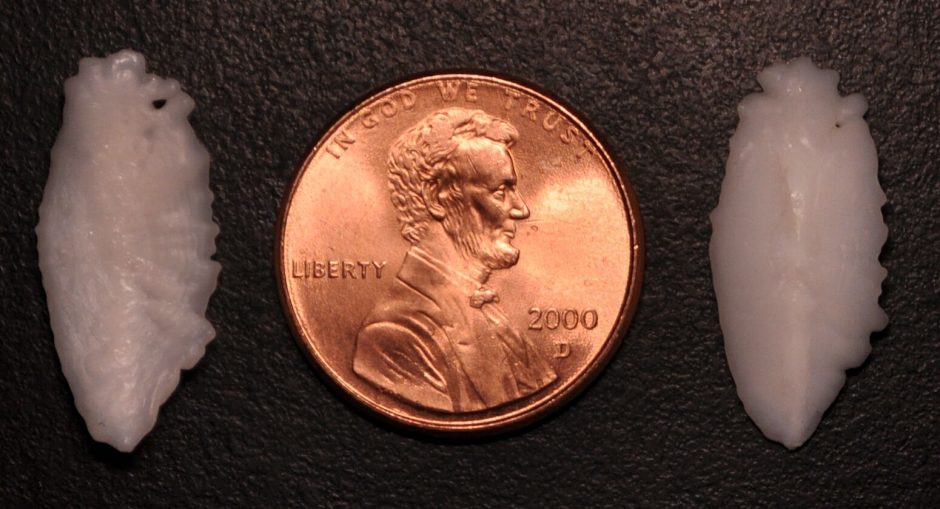High-Tech Surveying of Otoliths Help Track Hatchery Fish
 Pair of earbones or 'otoliths' from a black rockfish (Sebastes melanops) (Credit: Christian Zimmerman / USGS, via Wikimedia Commons CC BY-SA 3.0)
Pair of earbones or 'otoliths' from a black rockfish (Sebastes melanops) (Credit: Christian Zimmerman / USGS, via Wikimedia Commons CC BY-SA 3.0)Every year, thousands of state DNRs stock their waterways with popular or declining fish species in order to keep anglers and the ecosystem happy. These stocked fish are generally raised in a hatchery before being relocated to the target area. This relocation may occur very early in the juvenile fish’s life or closer to adulthood, depending on the needs of the fishery. Regardless of the stocked fish’s age, fishery managers must be able to distinguish between the various spawning populations to assess the impact of their work on fishable populations.
Aging Fish with Otoliths
One way researchers can identify a fish’s place of birth is by examining their otoliths, or ear bones. Otoliths serve the important function of keeping the fish oriented in the water and also reflect the age and history of the fish. Otoliths are sensitive to the environment and change depending on the age of the fish. Beyond being able to age specimen, otoliths also develop a unique chemical fingerprint as a result of the environment they grow up in.
In the past, otolith sampling has encountered several challenges that impact the reliability of the method. First, due to climate change, pollution and generally poor water quality, researchers have struggled to draw conclusions from damaged otoliths. In typical otolith samples, an aged fish will have various rings on the bone; these rings are formed annually and can determine the age of the fish, much like tree rings. However, when the environment is inhospitable, these rings do not develop correctly and, therefore, can give skewed results.
A similar phenomenon occurs with the unique chemical fingerprint, as the signature may become warped due to poor environmental conditions. More than just damaged chemical markers, fishery managers must also deal with a potential missing birth indicator. Since hatchery fish are often stocked early in life, the birth environment may not have enough time to form an impression.
Further, otolith surveys are not cost-free. In addition to the survey’s expenses, the fish being examined die due to the extraction. While nothing can be done to save the life of the fish being sampled, researchers from Ohio State University’s Aquatic Ecology Laboratory have developed a new method of analyzing otoliths to ensure the loss isn’t in vain.
Overcoming Otolith Survey Complications
Since hatchery fish are typically transported in a matter of days, the research team needed to develop a method that would be able to pick up even the smallest indicators of a chemical signature. Using lasers and plasma mass spectrometry, the researchers obtained more precise readings on the otoliths of walleye as young as two days old. Their findings, presented at the 2014 American Fisheries Society annual meeting, provide fishery managers with a uniform means of identifying both fish larvae and adults.
Not only does this finding provide an alternative method to otolith sampling that overcomes a major qualm with the strategy, but it also proves that otolith sampling still has a place in modern fishery management. This new technique allows hatcheries to continue using well-establish stocking methods. All of which, when combined with this new otolith sampling method, allow fishery and hatchery managers to keep track of the stocked and wild fish in the ecosystem.
Conclusion
Closely tracking the various populations and origins of fish in a habitat is important for future management decisions for both the hatchery and the fishery. If otolith surveys reveal a greater number of stocked fish compared to those born in the fishery, then managers would know to investigate the reason behind declining natural populations. The stocked fish may be out-competing the native fish, or native populations were already lower, meaning that the stocked fish are doing well in the new environment. Regardless of the positive or negative results of the otolith surveys, it’s important that the results be accurate above all else.


Rakshith Kumar
February 6, 2023 at 11:40 am
Very Informative on finding the age of fish by examine their otoliths